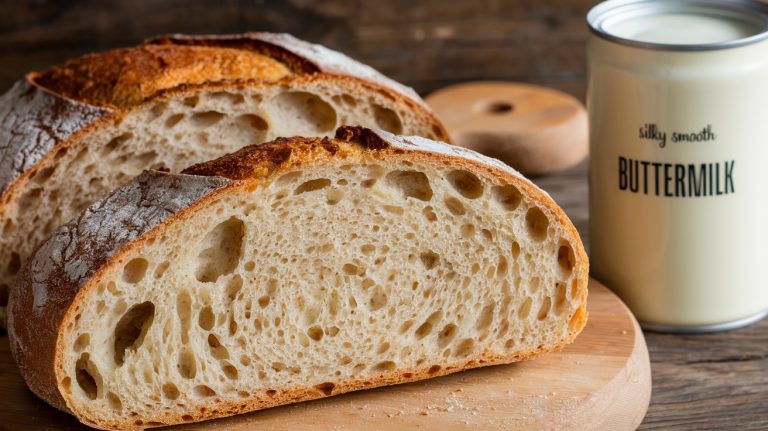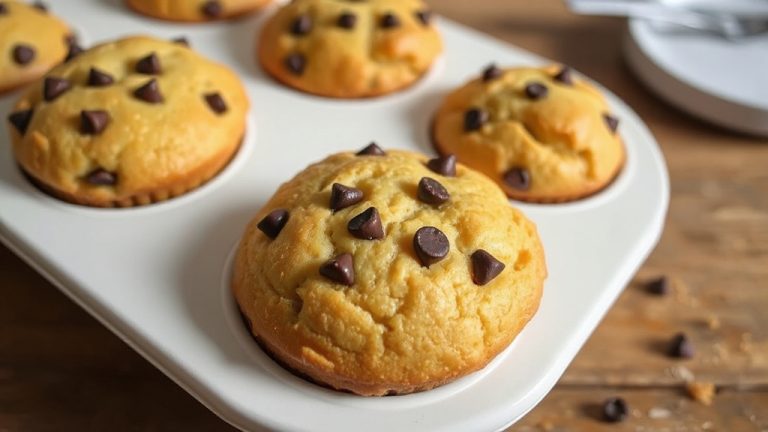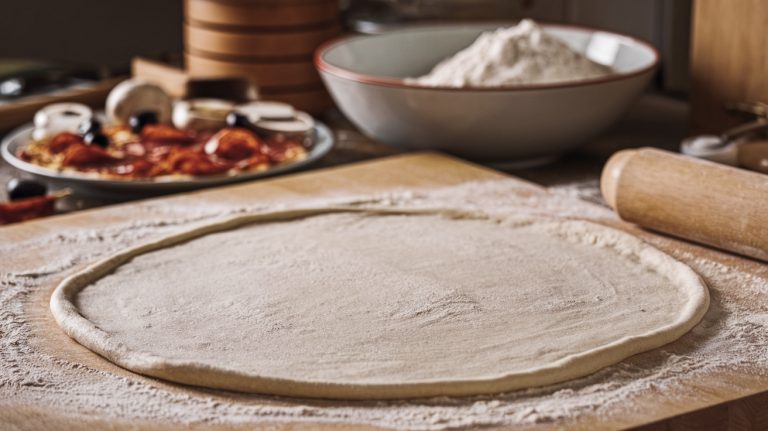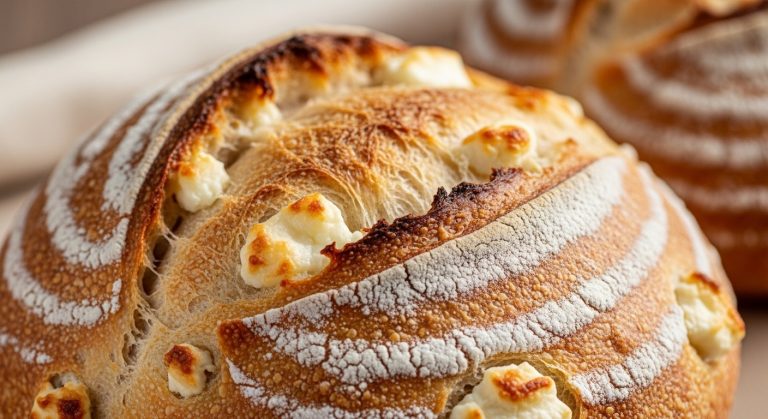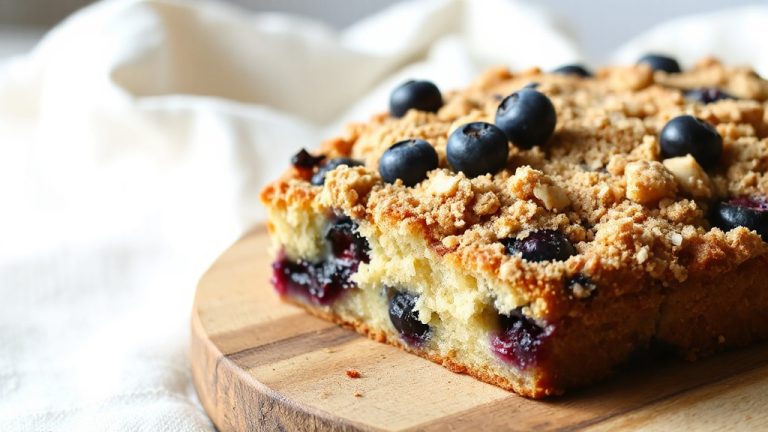Sourdough Discard Cinnamon Roll Recipe: Gooey, Waste-Free Treats
You can turn your sourdough discard into soft, gooey cinnamon rolls by mixing it with bread flour, milk, sugar, butter, eggs, and active starter.
Then knead until smooth and elastic. Spread a cinnamon-sugar-butter filling, roll tightly, slice, and proof until puffed.
Bake at 350°F until golden, then finish with cream cheese frosting or glaze. This approach cuts waste and boosts flavor.
Keep going to discover tips that’ll make your rolls irresistibly tender and perfectly sweet.
Key Takeaways
- Use active sourdough discard stored airtight in the fridge for up to a week to add flavor and reduce waste in cinnamon roll dough.
- Knead a dough of flour, discard, sugar, eggs, milk, butter, and salt until smooth and elastic, proofing until doubled at 75–80°F.
- Roll dough into a 1/4 inch thick rectangle, spread softened butter cinnamon-sugar filling evenly, then roll tightly and slice evenly.
- Proof shaped rolls in a greased pan until nearly doubled, then bake at 350–375°F for 25–35 minutes until golden and 190°F internally.
- Finish with cream cheese frosting or glaze, and optionally add pecans or extra cinnamon sugar for texture and flavor enhancement.
Quick Sourdough Discard Cinnamon Roll Recipe Breakdown
| Step | Ingredients/Tools | Key Actions & Tips |
|---|---|---|
| Dough Preparation | Bread flour, milk, sugar, butter, eggs, discard, salt | Mix and knead until smooth and elastic. Use active discard for rich flavor and aroma. |
| First Proof | Dough, bowl, cover | Proof in a warm spot (75–80°F) until doubled in size. |
| Filling | Butter (softened), brown sugar, cinnamon | Mash butter, sugar, and cinnamon until fluffy and spreadable. Add a pinch of salt for balance. |
| Assembly | Rolling pin, flour, dough, filling | Roll dough to ¼ inch thick rectangle, spread filling, roll tightly, and slice evenly. |
| Shaping and Second Proof | Greased baking pan, cut rolls | Arrange rolls seam-side down; proof again until puffy. |
| Baking | Oven (350°F), baking pan | Bake for 25–35 minutes until golden brown and 190°F internally. |
| Frosting/Topping | Cream cheese, buttercream, glaze, pecans | Frost when slightly cooled; customize with nuts or spice. |
| Serving & Storage | Airtight container, wrap | Store at room temp 1–2 days, refrigerate for longer freshness, freeze for future enjoyment. |
Understanding Sourdough Discard
Although many bakers toss it away, sourdough discard is actually a treasure trove of flavor and potential in your kitchen. Using it thoughtfully can help you achieve better baking results by measuring your ingredients precisely with a digital baking scale.
Many bakers overlook sourdough discard, but it’s a flavorful ingredient waiting to enhance your kitchen creations.
When you feed your starter, you remove some discard to keep the balance right and prevent it from growing too large. This discard is unfed starter that’s finished fermenting, so it’s less active but still packed with wild yeast and lactic acid bacteria.
It’s often misunderstood as waste, but it’s far from it. Its tangy acidity adds a unique flavor and tenderness to your baked goods. Keep it refrigerated and covered, and you can store it for a week or more. Storing in an airtight container helps maintain its quality during this time.
Using discard not only reduces waste but also gives your recipes a delightful depth, making it a smart, flavorful kitchen asset.
Essential Ingredients for Cinnamon Rolls

What makes cinnamon rolls irresistibly soft, flavorful, and tender? It all starts with the right ingredients.
You’ll want all-purpose flour for structure, sometimes blended with bread flour to boost chewiness. Warm milk and eggs keep the dough tender and help activate the yeast.
Unsalted butter adds richness, melted for easy spreading in the filling and softened in the dough for softness. Granulated sugar sweetens the dough and feeds the yeast, while brown sugar in the filling brings moisture and caramel depth.
Don’t forget the star spice: ground cinnamon, usually about a tablespoon or more, for that classic warm flavor. A pinch of salt balances sweetness and controls yeast activity, ensuring your rolls rise beautifully and taste just right.
Additionally, incorporating potato flakes into the dough can create an extra soft and fluffy texture that enhances the overall eating experience.
Equipment Needed for Baking
Now that you’ve gathered the perfect ingredients to make your sourdough cinnamon rolls soft and flavorful, it’s time to equip your kitchen with the right tools.
Start with mixing bowls made of glass or metal and a digital kitchen scale for precise measurements. Accuracy here guarantees your dough’s perfect hydration, which is essential for the dough’s gluten structure.
Use glass or metal mixing bowls and a digital scale to ensure your dough’s hydration is perfectly precise.
A dough whisk will help you mix sticky dough without overworking it, while bench and dough scrapers keep your workspace clean and help handle the dough easily.
For proofing, grab a banneton basket lined with a floured towel to maintain shape, plus bowl covers or plastic wrap to keep moisture in. Proper maintenance and consistent care of your banneton ensure optimal proofing conditions.
When baking, an 8-inch greased dish works best for these rolls, and a cooling rack prevents soggy bottoms. Using a preheated baking vessel like a Dutch Oven can further improve crust texture and oven spring.
Don’t forget oven mitts for safe handling of hot pans!
Preparing the Dough
To get your dough just right, you’ll want to measure your ingredients carefully. Trust me, it makes a difference! When it comes to mixing and kneading, following some precise techniques is key. Just pay close attention to how the dough feels as you’re working it.
The quality of your ingredients can significantly impact the final texture and rise of your dough, so choosing high-quality flours is essential. You’re aiming for a smooth, slightly tacky ball, which is really the sweet spot. Using a stand mixer with a dough hook can make kneading easier and help achieve the desired dough texture.
Now, let’s talk about proofing. Mastering that process is so important! It’s what guarantees that your cinnamon rolls rise perfectly every single time. For best results, let the dough rise in a covered container in a warm spot until it has doubled in size, usually about an hour, which ensures reliable, quick rise.
Ingredient Measurements Guide
Crafting the perfect sourdough discard cinnamon roll starts with precise ingredient measurements that set the foundation for your dough’s texture and flavor.
Use 300 to 500 grams of bread flour for strong gluten development, adjusting slightly if your kitchen feels warm to prevent stickiness. For gluten-free alternatives, consider using a gluten-free flour blend to achieve a similar texture.
Incorporate 100 to 250 grams of bubbly, active starter or modify when using discard by adding baking soda for lift.
Measure 120 to 190 grams of whole milk at room temperature, complemented by 35 to 115 grams of softened butter for richness.
Add 1 to 2 eggs to boost elasticity.
Balance sweetness with 25 to 50 grams of sugar, typically granulated or brown, and fine-tune salt at 5 to 10 grams to enhance flavor without hindering fermentation.
Accurately weighing each ingredient guarantees your dough rises beautifully and tastes incredible. This recipe uses a one-bowl dough mixing method for simplicity and efficiency.
Mixing and Kneading Techniques
Measuring your ingredients with care sets you up for success, but how you mix and knead the dough truly shapes the texture and rise of your sourdough discard cinnamon rolls.
Start by combining your starter, flour, sugar, and eggs gradually, adding flour bit by bit to avoid overmixing. If you have a stand mixer, use the dough hook at low to medium speed. Knead for 8-10 minutes until the dough becomes smooth and elastic. This process helps develop the gluten structure necessary for trapping carbon dioxide during fermentation.
Don’t forget to scrape down the bowl regularly to incorporate everything evenly. If kneading by hand, keep going until you feel that satisfying stretch in the dough.
Aim for a soft, moist consistency that isn’t sticky. Using an active, bubbly sourdough starter fed 4-12 hours prior is key to achieving the best rise and flavor in your dough active starter.
This careful mixing and kneading builds the gluten structure essential for those tender, fluffy cinnamon rolls you’re craving.
Dough Proofing Tips
Although proofing might seem like a passive step, it’s where your dough truly transforms, developing flavor, structure, and that perfect rise.
To nail your sourdough discard cinnamon rolls, keep these tips in mind:
- Proof at 70-75°F (21-24°C) for balanced fermentation; avoid temps above 85°F to prevent overproofing.
- Bulk ferment until the dough nearly doubles, folding every 30 minutes to build gluten and trap gas bubbles.
- Use the poke test: a slow rebound means perfect proofing; quick bounce back means underproofed.
- Cover your dough to keep it moist. Plastic wrap, damp towels, or a lidded container work wonders.
Using nitrile gloves during kneading can help maintain cleanliness and improve grip when handling sticky dough.
Trust these steps to get a smooth, elastic dough that’s easy to shape and bakes into delightful, fluffy rolls.
Making the Cinnamon Sugar Filling
Once you’ve softened your butter to room temperature, you’re ready to blend it with cinnamon and sugar to create the rich, aromatic filling that makes these cinnamon rolls unforgettable. This step is key to mastering the fundamentals of pastry that ensure consistent texture and flavor.
Start with about a half cup of butter, one cup of brown sugar, and two tablespoons of cinnamon. Mash them together with a fork or mixer until you get a fluffy, spreadable paste.
Mix ½ cup butter, 1 cup brown sugar, and 2 tablespoons cinnamon until fluffy and spreadable.
This texture helps the filling spread evenly and prevents it from leaking when you roll the dough.
For a balanced flavor, add a pinch of salt, and if you want, a little vanilla or even a touch of cornstarch to thicken.
Preparing the cinnamon sugar filling is a crucial step before assembling the rolls, as it ensures the rolls have a rich cinnamon sugar filling that complements the sourdough dough perfectly.
Rolling and Shaping the Rolls
Alright, let’s get started! First things first, you’ll want to sprinkle a bit of flour on your countertop and your rolling pin. This will help keep the dough from sticking while you roll it out into a nice, even rectangle.
For an ideal shape and rise, pat the dough into a rectangle and let it rest for 10 minutes before rolling it out fully. Adjusting the hydration levels of your dough can also improve its elasticity and ease of rolling.
Once you’ve got your dough rolled out, it’s time to spread that delicious cinnamon-sugar filling all over it. Make sure you cover it well!
After that, roll the dough up tightly from the short end. You’ll want to create a neat log so your cinnamon rolls come out looking perfect.
Now, it’s time to cut your log into even slices. Take your time with this step to ensure they’re all about the same size. This way, your classic cinnamon rolls will bake evenly and look amazing when they come out of the oven! Arrange the rolls seam-side down in the pan to maintain their shape during the second rise and baking.
Dough Rolling Techniques
When you prepare to roll out your sourdough discard dough, treating your workspace thoughtfully can make all the difference in how smoothly the process goes. Lightly oil and flour your countertop, and dust the dough and rolling pin sparingly to prevent sticking without toughening the dough. Gently pat the dough into a rough rectangle to relax the gluten before rolling.
Here’s how to roll like a pro:
- Roll into a 16” x 12” rectangle about 1/4 inch thick for even baking.
- Start rolling from the shorter edge with filling to keep spirals tight.
- Tuck and seal the dough edge as you roll to prevent unraveling.
- Keep the roll seam side up after rolling to maintain shape and seal. Allowing the shaped rolls to proof in a warm place covered with a damp towel helps achieve a soft, puffy texture before baking.
This method ensures tight, even cinnamon rolls ready for slicing!
Shaping Cinnamon Rolls
Although rolling and shaping cinnamon rolls might seem straightforward, giving attention to each step makes certain you get those perfect spirals and fluffy textures.
Start by lightly flouring your work surface and spreading softened butter evenly on the dough, leaving a small border. Using softened or slightly melty butter in the filling helps prevent gaping and ensures a smooth texture. Proper wrapping and freezing techniques can help preserve this texture if you plan to store the rolls before baking, as explained in recommended freezing techniques.
Sprinkle your cinnamon-sugar filling uniformly, then roll tightly from the long edge, applying even pressure to avoid gaps.
Seal the seam and flip it seam-side down before slicing with a sharp, oiled knife or floss for clean cuts. Ensuring the dough is rolled into an 18×12 inch rectangle for large rolls helps achieve the ideal size and shape.
| Step | Tip |
|---|---|
| Surface Prep | Flour surface lightly |
| Rolling | Roll tight, seal seam well |
| Cutting | Use sawing motion, spaced intervals |
This method ensures neat, evenly sized rolls ready for proofing.
Proofing and Baking Instructions
Once your dough has risen to a perfect, doubled size, it’s time to shape and proof your cinnamon rolls for that soft, airy texture you crave.
After rolling and cutting, place the rolls in a greased pan and cover them. Here’s what to do next:
Place your cut rolls in a greased pan, cover, and prepare for the final proof before baking.
- Let the rolls proof at room temperature until puffed and nearly doubled, about 1–2 hours. This rise time allows the dough to develop its yeasty flavor and texture.
- If refrigerated overnight, bring rolls to room temperature for 30–60 minutes before baking.
- Preheat your oven to 350–375°F (175–190°C) while the rolls finish proofing.
- Bake rolls for 25–35 minutes, rotating halfway, until golden brown and an internal temp of 190°F (88°C).
Cool them in the pan 10–15 minutes before frosting to keep that perfect softness intact.
Frosting and Topping Options

Since the perfect cinnamon roll deserves an equally delicious finish, choosing the right frosting and toppings can elevate your sourdough discard creation to a whole new level. You might whip up a tangy cream cheese frosting with a hint of vanilla or a sweeter, lighter buttercream drizzled with maple syrup.
Don’t forget to add texture with crunchy pecans or a dusting of cinnamon sugar for that extra aroma. Using leftover sourdough discard in the dough not only adds flavor but also helps reduce waste in the kitchen. For best results when measuring your ingredients, consider using accurate measuring spoons to ensure consistent flavor and texture.
| Frosting Type | Flavor Profile & Texture |
|---|---|
| Cream Cheese | Tangy, rich, fluffy |
| Buttercream | Sweet, smooth, drizzle-friendly |
| Powdered Sugar Glaze | Light, sweet, glossy |
| Nut Toppings | Crunchy, contrasting |
Feel free to customize with spices or citrus zest to make it uniquely yours!
Tips for Perfect Cinnamon Rolls
When you want cinnamon rolls that are soft, gooey, and perfectly risen, controlling your dough’s temperature and timing is key. Here’s how you nail it every time:
- Let your dough rise until it doubles in size at 75–80°F; use a warm oven (150°F turned off) if needed. Check readiness with the poke test—an inch-deep indent that slowly bounces back.
- Roll the dough gently into a rectangle, leaving a border free of filling to seal. Don’t roll too tight to avoid spills and uneven shapes.
- Cut rolls with dental floss or a serrated knife into uniform slices for even baking.
- Bake at 350–375°F until golden, checking that rolls spring back lightly but remain soft in the center for that irresistible gooey texture.
Frequently Asked Questions
Can I Freeze Sourdough Discard Cinnamon Rolls Before Baking?
Yes, you can freeze sourdough discard cinnamon rolls before baking. Just shape them, cover tightly with plastic wrap, and pop them in an airtight container.
When you’re ready, thaw them overnight at room temperature and let them rise until puffy before baking. This way, you keep their flavor and texture intact.
It’s perfect if you want to prep ahead or save time while still enjoying fresh, homemade rolls.
How Do I Store Leftover Cinnamon Rolls for Best Freshness?
To keep your leftover cinnamon rolls fresh, wrap them tightly in plastic wrap and store them in an airtight container. If you plan to eat them within 2 days, room temperature is fine.
For longer freshness, pop them in the fridge for up to a week. When reheating, warm them gently and frost just before serving to keep that soft, gooey texture you love.
For longer storage, freezing is your best bet!
Can I Substitute Gluten-Free Flour in This Recipe?
Can you substitute gluten-free flour? Absolutely, if you’re ready to set out on a sticky, slightly crumbly adventure!
Use a gluten-free blend with xanthan gum or psyllium husk to mimic elasticity. Expect a softer, pillowy texture and adjust liquids thoughtfully since gluten-free flours behave like divas.
Warm proofing or overnight chilling helps too. So, go ahead—your cinnamon rolls mightn’t rise like a champ, but they’ll sure taste like a cozy hug!
What’s the Best Way to Reheat Cinnamon Rolls Without Drying?
To reheat cinnamon rolls without drying them out, you’ll want to keep things moist and gentle.
Wrap your rolls in foil after adding a little butter or water, then warm them in a 350°F oven for about 10-15 minutes.
If you’re using a microwave, cover them with a damp paper towel and heat for just 20-30 seconds.
These tricks lock in moisture and keep your rolls soft and gooey.
How Long Do Sourdough Discard Cinnamon Rolls Keep at Room Temperature?
You can keep your unfrosted sourdough discard cinnamon rolls at room temperature for about 1 to 4 days if you store them properly in an airtight container.
This helps maintain their soft texture and freshness.
Just avoid leaving frosted rolls out since the frosting can spoil quickly.
For the best taste, enjoy them within that timeframe or pop them in the fridge if you want to extend their life a little longer.
Don’t Toss That Starter: Make Cinnamon Rolls Instead
By using sourdough discard in your cinnamon rolls, you’re joining a growing group of home bakers. Over 60% have embraced this tasty way to reduce waste!
It’s more than just a recipe; it’s a delicious way to give new life to what you’d normally toss. So, don’t hesitate—roll up your sleeves, enjoy the process, and savor every bite of these soft, flavorful cinnamon rolls that make your kitchen smell like heaven.


